If you’re getting ready to clean out the garage, repair the shed, or otherwise “invade” potential spider territory, you might want to know which are the most dangerous spiders in Louisiana. Thankfully, they’re all fairly easy to identify and not terribly aggressive, or common. But these nasty arachnids can make you sick if they bite you. Learning how to identify them and know where they build their webs can help you avoid them this summer.
Let’s take a look.
Northern Black Widow
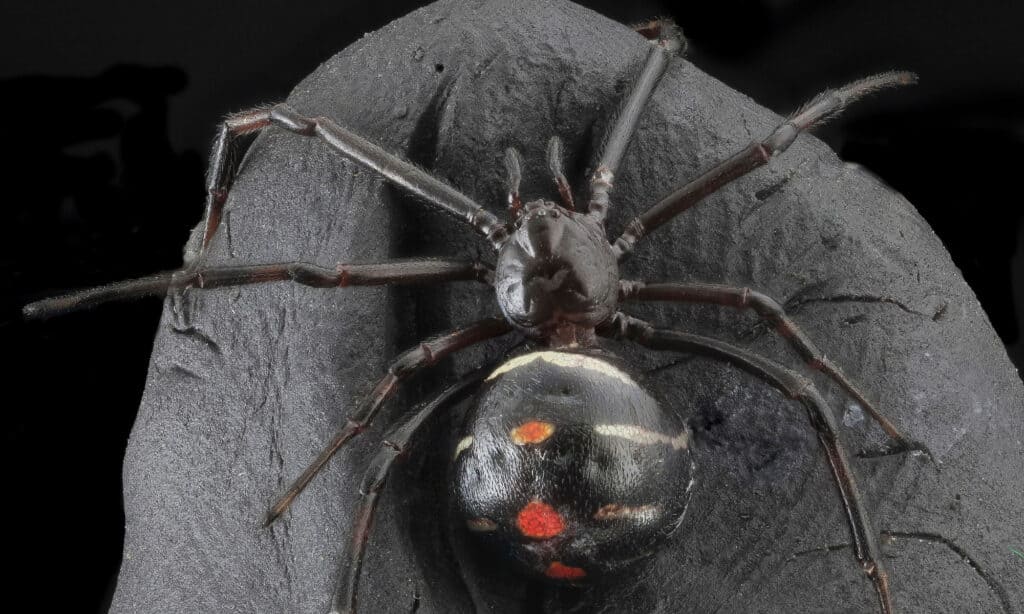
Unlike other black widows, northern black widows have a broken hourglass-shaped marking on their abdomens. This makes them easily identifiable as one of the most dangerous spiders in Louisiana.
©Porco_Rosso/Shutterstock.com
For many, the name “black widow” induces extreme fear and concern. With the toxic venom their bite packs, it’s no wonder.
Northern Black Widow Spider Identification
When most folks think of black widows, they picture the black body and red hourglass. In the case of the northern black widow, though, you may be in for a surprise. The northern species has a fracture hourglass of red on its abdomen. They grow to about 0.16 and 0.4 inches long, making them moderate to small spiders.
Northern Black Widow Spider Habitats
Northern black widows prefer dark enclosed spaces where they can weave their three-dimensional webs. They may be found inside human-built structures like houses and sheds, warehouses and garages, or around wood piles and fences.
Symptoms of Northern Black Widow Spider Bites
Most folks bitten by northern black widow spiders experience mild to moderate symptoms that include:
- Moderate to severe pain
- Muscle rigidity
- Intense sweating (known as latrodectism)
- Redness around the wound
More severe symptoms include:
- Muscle cramps or spasms beginning near the bite and spreading outward
- Seizures
- Chills and fever
- Nausea
- Vomiting
- Severe belly, back, or chest pain
- Severe high blood pressure
- Headaches
- Dizziness, stupors, or shock
Southern Black Widow
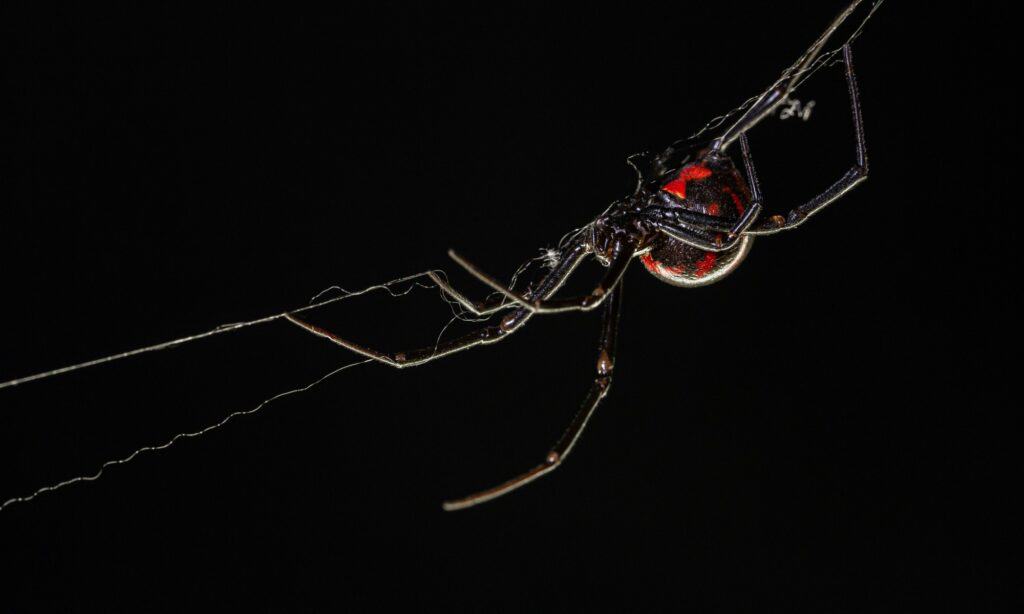
The southern black widow has a distinctive red hourglass marking on its abdomen. Famously, they are one of the most dangerous spiders in Louisiana, as well as many other states in the USA.
©iStock.com/AmericanWildlife
More folks are familiar with the appearance of the southern black widow. Technically, the northern and southern are two different species, but they bear many similarities.
Southern Black Widow Spider Identification
Southern black widows bear the full, bright red hourglass marking on the underside of their abdomens. Their bodies are shiny, jet black, and rounded, with most bearing another red dot on the back of the abdomen. Males and young southern black widows tend toward purple coloration or gray-black, with white stripes and yellow or orange dots.
Southern Black Widow Spider Habitats
Just like the northern black widow, the southern variety likes urban and suburban areas where human-made structures provide places to spin their webs. Look out for them in dark, secluded places with lots of objects around for attaching their webs to.
Symptoms of Southern Black Widow Spider Bites
The same symptoms appear for victims of southern black widows, as listed above.
Brown Widow
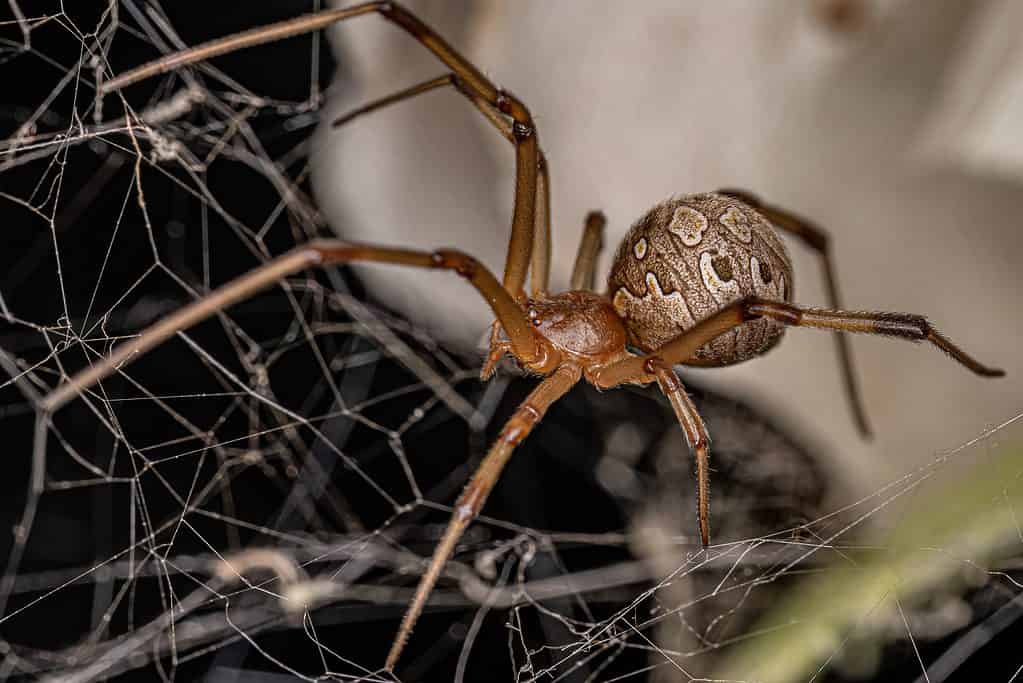
Brown widow spider of the species
Latrodectus geometricusis not native to Louisiana, but it invaded the state and became one of the most dangerous around.
©Vinicius R. Souza/Shutterstock.com
Lesser known, brown widows are not actually native to Louisiana, but they’ve made their way here nonetheless. Assumptions place them natively in either Africa or South America, though their true origins are a bit uncertain.
Brown Widow Spider Identification
These widow spiders come in beige, tan, and brown shades, with dark brown cephalothorax. Their legs may be tan, brown, or black segments. The cream-colored abdomen helps folks identify them, with the orange hourglass marking on the underside. These arachnids reach up to one inch in length.
Brown Widow Spider Habitats
Brown widows are partially so dangerous because of their preference for living in populated areas. They frequently build webs in patio furniture, play sets, picnic tables, benches, and other places folks like to congregate outdoors.
Symptoms of Brown Widow Spider Bites
While the black widow is far more infamous, the brown widow venom is actually twice as dangerous. However, the spider uses its venom more sparingly and winds up injecting far less of it into its human victims than its cousin.
The same sorts of symptoms may be experienced with brown widows as with black widows, however, particularly if the victim is allergic to spiders, vulnerable, or if the spider manages to inject more of its venom for any reason.
Brown Recluse
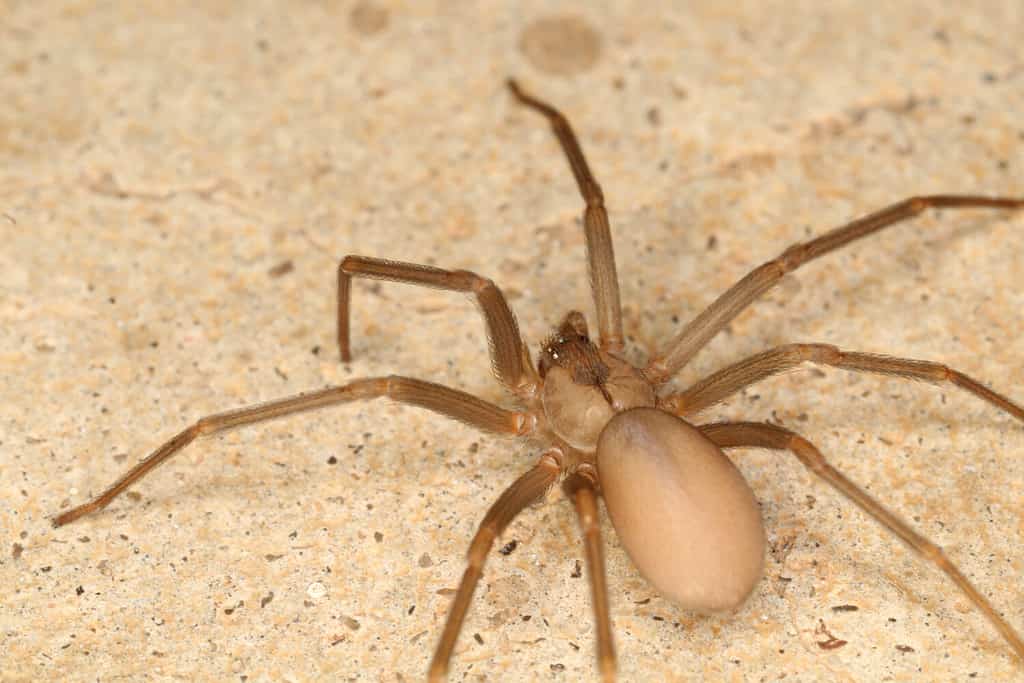
The brown recluse spider prefers to hide away (earnings its name) so bites are not particularly common. But these arachnids can cause necrosis of the flesh if you’re bitten by them.
©Nick626/Shutterstock.com
These nasty little “fiddle” spiders, or “violin” arachnids, known as brown recluses, pack a nasty bite full of two types of toxins. Most folks bitten won’t have severe health consequences, but the elderly, children, and those with allergies will need medical care immediately.
Brown Recluse Spider Identification
Brown recluse spiders are, as you’d guess by the name, most commonly brown in color. They bear pale brown violin-shaped patterns on their bodies, which are white to dark brown or dark gray. Brown recluse spiders only have six eyes, which also helps make them easy to identify. Other spiders have eight.
This venomous spider is significantly smaller than black widows, with bodies from one-quarter to three-quarter inches. The nasty spiders have eight legs, as all spiders do, but you might spot one without all of them still attached. These little critters may self-amputate a limb to escape predation.
Brown Recluse Spider Habitats
Dark, remote corners welcome brown recluses, largely earning them their names. These spiders are solitary, prefer not to interact with other creatures, save dinner, and like hiding away from the world. Often, you’ll find them hunting for food in these dark corners, or hanging out on their webs in cardboard, cellars, woodpiles, sheds, and the backs of closets.
Brown Recluse Spider Bites
Carrying both necrotic and hemotoxic venom, brown recluse bites are some of the nastiest spider bites of all. The reason they rank so low, though, is they tend to shy away from people and rarely express aggression.
If someone is bitten, though, the symptoms are challenging, to say the least. You may experience any or all of the following.
- Red, irritated skin
- Swelling and blistering
- Soreness
- Necrotic decay of flesh
- Itching
- Moderate to severe pain
- Lethargy
- Flu-like symptoms, including body aches, chills, and fever
- Flat purple or red spots or rashes all over the body
It takes many folks between 6 and 8 weeks to fully recover from these bites. If you have been bitten, you should seek medical attention immediately.
Black-Footed Yellow Sac Spider
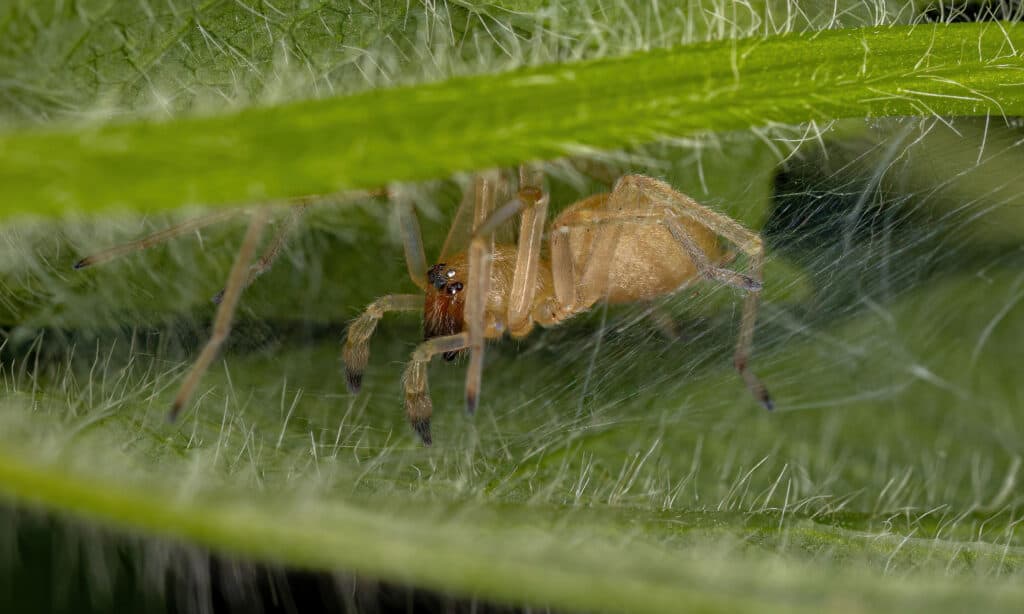
The black-footed
yellow sac spider
builds a silk sac to protect itself from predators during the day. It’s thankfully not incredibly dangerous, making most people “irritated” more than ill. But if you’re allergic, their venom can still cause significant problems.
©iStock.com/ViniSouza128
Tiny venomous spiders are still venomous – and the black-footed yellow sac spider is one of the most dangerous in Louisiana. They aren’t as common as other species, but you’ll find them more aggressive than black widows.
Black-Footed Yellow Sac Spider Identification
Small, yellow, yellow-orange, or light brown bodies about one-quarter inch make up the majority of the bulk of the black-footed yellow sac spider. Their legs reach as long as 1 inch. Orange-brown lines run down the abdomen, while dark brown to black markings tip their legs (giving them their moniker), jaws, and palps.
Black-Footed Yellow Sac Spider Habitats
Black-footed yellow sac spiders strongly favor forest dwellings over all others. However, as the urban world spreads, so too spreads their domain. Most commonly, you’ll find these irritating arachnids in your garden or within a few yards of their webs inside your home.
Symptoms of Black-Footed Yellow Sac Spider Bites
Thankfully, the black-footed yellow sac spider holds a limited threat to humans as they rarely bite and are not particularly dangerous. They do have venom in their fangs, however, and they do sometimes bite people. A single bite will cause discomfort or pain, itching, and swelling. These symptoms should be mild to moderate in most folks. If, however, you notice more severe symptoms or significant swelling, seek medical attention immediately.
What to Do if Bitten
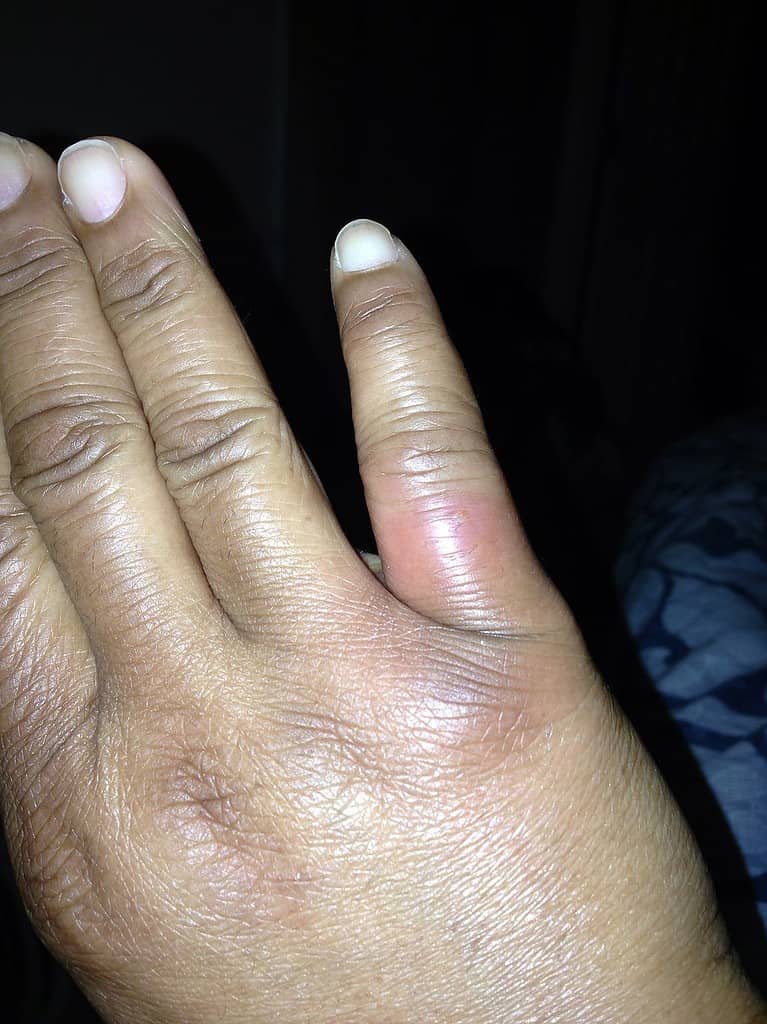
Brown recluse bites and others usually show the mark where a bite occurred, with swelling and pain spreading outward from the wound.
If you or a loved one are bitten by a spider, you should:
- Immediately clean the bite wound with gentle soap and water.
- Apply a damp, cool cloth or ice pack.
- If possible, elevate the wound above the heart.
- Take over-the-counter painkillers and anti-inflammatory medication to ease symptoms.
If the symptoms worsen, seek immediate medical attention to prevent infection or worsening conditions.
The photo featured at the top of this post is © Pong Wira/Shutterstock.com
Thank you for reading! Have some feedback for us? Contact the AZ Animals editorial team.







